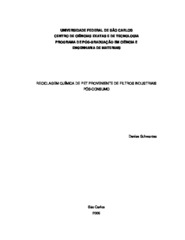| dc.contributor.author | Schwantes, Denise | |
| dc.date.accessioned | 2016-06-02T19:10:00Z | |
| dc.date.available | 2009-09-25 | |
| dc.date.available | 2016-06-02T19:10:00Z | |
| dc.date.issued | 2006-03-10 | |
| dc.identifier.citation | SCHWANTES, Denise. INDUSTRIAL FILTER BAG CHEMICAL RECICLING. 2006. 123 f. Tese (Doutorado em Ciências Exatas e da Terra) - Universidade Federal de São Carlos, São Carlos, 2006. | por |
| dc.identifier.uri | https://repositorio.ufscar.br/handle/ufscar/658 | |
| dc.description.abstract | The PET filter bag is used in the separation of the particulates materials of the gas produced in the aluminum industry. It had been submitted a chemical recycling. Almost industries make the disposal of these materials in industrial earthwork or still they take the centers that make the energy recycling. The filter bag restrained particulate is constituted by alumina with adsorbide fluoride and an amount of carbon proceeding from the electrolytic decomposition of anode pots. The adhesion of particles in the interior becomes the filters of difficult recycling mechanics, because the incrusted materials are not removed by the laundering. So, the filters of this work had been recycled chemically through glycolysis with ethylenoglycol. For the reactions under ambient pressure it was observed that it has the necessity to use catalyst to speed up the reaction. The catalyst used was the sodium bicarbonate. The best condition found for reactions the ambient pressure form: temperature of 190°C, 1% of catalyst and 20 hours of reaction. With these conditions the glicolysis convrtion was almost 94%. It was not possible to determine the order of ration for this system. The reactions carried through with a closed reactor had allowed increasing the
temperature of the system. So, the temperature is the variable most important, reaching bigger conversions in a lesser time that the gotten time the ambient pressure. The best joined conditions had been 1% of catalyst, 190°C and 10
hours of reaction and also 0.5% of catalyst, 230°C and 5 hours of reaction. For these conditions, the reaction rate was little bigger than 99%. | eng |
| dc.format | application/pdf | por |
| dc.language | por | por |
| dc.publisher | Universidade Federal de São Carlos | por |
| dc.rights | Acesso Aberto | por |
| dc.subject | Polímeros | por |
| dc.subject | Reciclagem de materiais poliméricos | por |
| dc.subject | Glicólise | por |
| dc.subject | Reciclagem química | por |
| dc.title | Reciclagem química de PET proveniente de filtros industriais pós-consumo | por |
| dc.title.alternative | INDUSTRIAL FILTER BAG CHEMICAL RECICLING | eng |
| dc.type | Tese | por |
| dc.contributor.advisor1 | Zanin, Maria | |
| dc.contributor.advisor1Lattes | http://genos.cnpq.br:12010/dwlattes/owa/prc_imp_cv_int?f_cod=K4783151H2 | por |
| dc.description.resumo | Mangas filtrantes de PET como material filtrante são utilizados na separação de materiais particulados provenientes dos gases produzidos na indústria do alumínio foram submetidos a reciclagem química. A maioria das indústrias faz a disposição das mangas em aterros industriais ou ainda encaminham para centros que fazem a reciclagem energética. O particulado
retido é constituído por alumina com fluoreto adsorvido e uma quantidade de carbono proveniente da decomposição do anodo das cubas eletrolíticas. A adesão das partículas no interior torna os filtros de difícil reciclagem mecânica,
porque os materiais incrustados são de difícil remição por sistemas de lavagem. Dessa forma, os filtros deste trabalho foram reciclados quimicamente através de glicólise com etilenoglicol em diferentes condições. Para as reações a pressão ambiente foi observada que há a necessidade de utilizar catalisador para acelerar a reação. O catalisador utilizado foi o bicarbonato de sódio. A melhor condição encontrada para reações a Pressão ambiente foi: temperatura
de 190°C, 1% de catalisador e 20 horas de reação. O valor de conversão desta reação ficou em torno de 94%. Não foi possível determinar a ordem de reação para este sistema. As reações realizadas com um reator fechado permitiram
aumentar a temperatura do sistema mesmo utilizando o etilenoglicol com temperatura de ebulição de 192°C. Nestas reações, a temperatura é a variável mais importante, atingindo maiores conversões em um tempo menor que o
tempo obtido a pressão ambiente. As melhores condições encontradas foram 1% de catalisador, 190°C e 10 horas de reação e também 0,5% de catalisador, 230°C e 5 horas de reação. Para estas condições a conversão foi maior que
99%. | por |
| dc.publisher.country | BR | por |
| dc.publisher.initials | UFSCar | por |
| dc.publisher.program | Programa de Pós-Graduação em Ciência e Engenharia de Materiais - PPGCEM | por |
| dc.subject.cnpq | ENGENHARIAS::ENGENHARIA DE MATERIAIS E METALURGICA | por |
| dc.contributor.authorlattes | http://lattes.cnpq.br/5557023803320494 | por |
